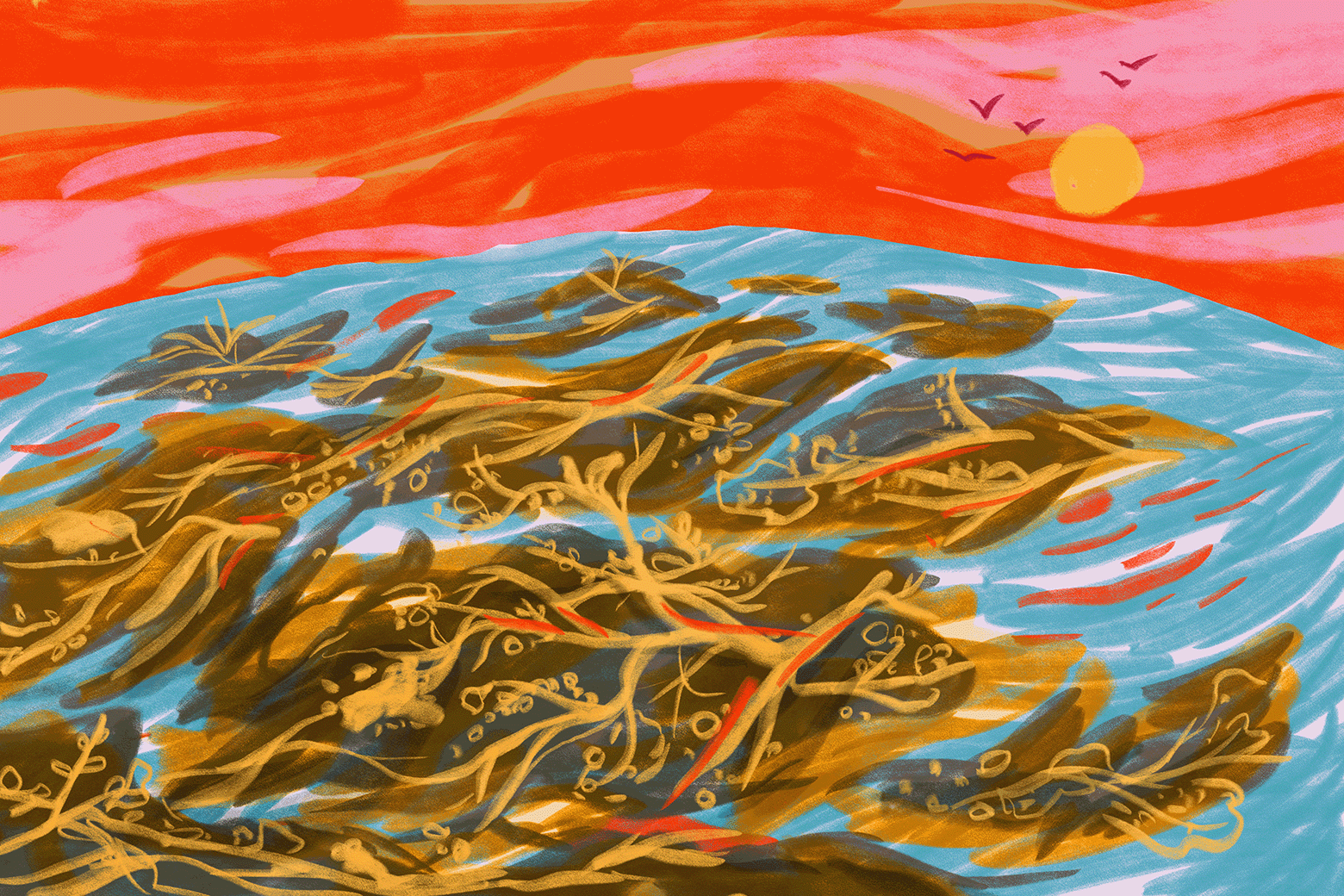Hot Sargassum Summer
Millions of tons of algae are landing on beaches around the Atlantic. What is this stuff, why is it here, and perhaps most importantly—what should we do about it?
This past April, scientists started to understand that this year’s “blob” was a lot larger than it should be. It was even moving rapidly through the Atlantic Ocean.
The blob they were watching was the sargassum bloom—an annual event that sends mats of light-brown algae floating across the Caribbean, through the Gulf of Mexico, and eventually, in some cases, up the East Coast of the United States. They were studying satellite images of the equatorial Atlantic Ocean and began to notice that a 5,000-mile-long belt of sargassum, holding over 20 million tons of the seaweed, was drifting through the water—the largest bloom ever recorded so early in the year.
What that meant wasn’t exactly clear. To some, the algae represented a looming nuisance that threatened tourism. To others, it was a full-blown public health crisis. Some reporting suggested that the sargassum hosted high levels of a flesh-eating bacteria, prompting the Florida Department of Health to issue an advisory warning people not to swim in excessive amounts of seaweed. A doctor at Baylor College of Medicine warned that the seaweed can emit hydrogen sulfide as it decomposes—a chemical asphyxiant that can lead to nausea, eye irritation, and, in the most extreme cases, death (although she also noted that on the open-air beaches, where the seaweed would mostly wash up, those risks were low).
For communities in the Caribbean and the Gulf of Mexico, the near-term impacts were easy to predict. A lot of sargassum would pile up on beaches, where it would decompose, attracting flies and causing a big stink. Keeping beaches sargassum-free has become an annual chore at resorts in destinations like Tulum and Punta Cana—work that requires massive nets, bulldozers, backhoes, flatbed trucks, shovels, pitchforks, and a lot of time and labor. It’s become such a burden that the Mexican navy has even been building barriers in the ocean to keep the algae offshore, and deploying special sargassum patrols to intercept it before it reaches shore. The sargaceros who clean the algae up in Mexico work long shifts in punishing sunlight, and make the equivalent of $260 a month shoveling sargassum off the beaches and hauling it into trucks that bring it to landfills. All signs indicated that this would be a particularly brutal season.
The biggest groans, however, didn’t come from the sargaceros tasked with actually moving those slimy masses. Vacationers were quick to denounce the Sargassum Summer, turning to resources such as sargassummonitoring.com and the Florida Department of Environmental Protection’s Algal Bloom Dashboard to help them attempt to plan seaweed-free vacations. T-shirts and tank tops designed for the Cancun crowd popped up, with phrases like “Spring Break 2023: Sargassum Sucks” and (I’m sorry) “Not the ’Gasm I Was Expecting” emblazoned over cartoon drawings of sargassum fronds. In recent years, as blooms have expanded, travelers in the affected areas have taken to TripAdvisor to vent about their experiences, penning reviews of beach resorts with titles like “Sargassum seaweed is taking over the place,” “Holy Sargassum,” and “Too Much Seaweed.”
“Although the resort tried its best to keep up with it,” wrote
one user, “the smell of rotting seaweed destroyed the beach
experience.” All of this, I should add, before reports of flesh-eating
bacteria began to emerge.
For Amy Siuda, a scientist at Eckerd College in Florida who studies the seaweed, the recent surge in sargassum has brought sudden, unexpected attention to her research. “Nobody really cared about what we were doing before it started washing ashore on the beaches,” she said.
Siuda has been working with sargassum her entire career. When she finished her undergraduate studies in around 2000, she began working at the Sea Education Association—an organization based out of Woods Hole, Massachusetts, dedicated to research on the high seas. S.E.A. researchers teach aboard their vessels while collecting data on plastics, marine microorganisms, and, of course, sargassum.
“I was sailing in the Sargasso Sea constantly and seeing this incredible ecosystem that we would pass by and collect in our nets and examine,” she said. “I’ve been really interested in the ecology and distribution of sargassum for a while now.”
The Sargasso Sea, where Siuda began her career, is named after the seaweed that for centuries (at least) has been found there in large quantities. Instead of the coastlines that define the boundaries of most bodies of water, the 600-mile-wide Sargasso is surrounded by several ocean currents—the Gulf Stream, the North Atlantic Current, the Canary Current, and the North Equatorial Current—that meet there. Because of that convergence, it’s the natural landing place for a lot of the stuff that’s floating in the Atlantic, such as plastic, but the currents also serve to slingshot pelagic sargassum, the majority of which has historically originated there, out into the rest of the ocean. The new belt of Sargassum, however, represents a change in that dynamic.
Read More Here: Slate







